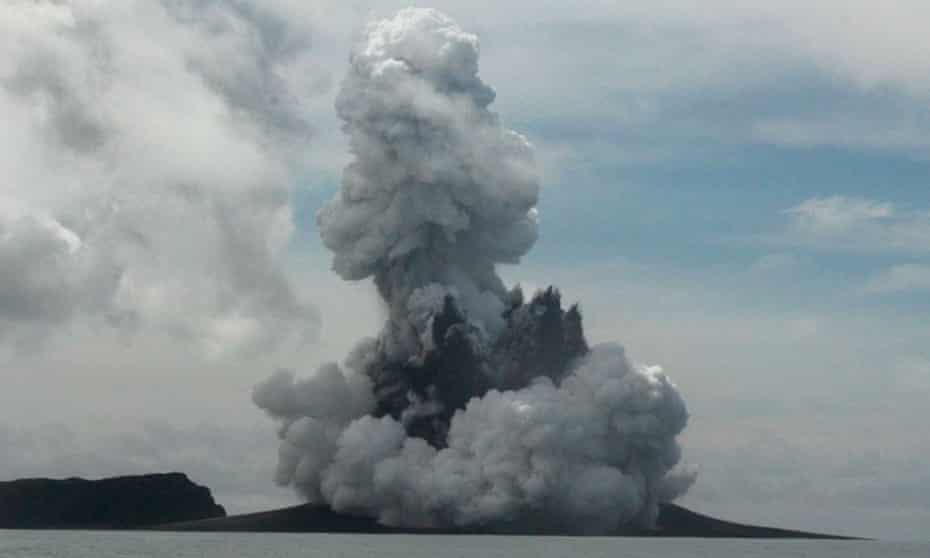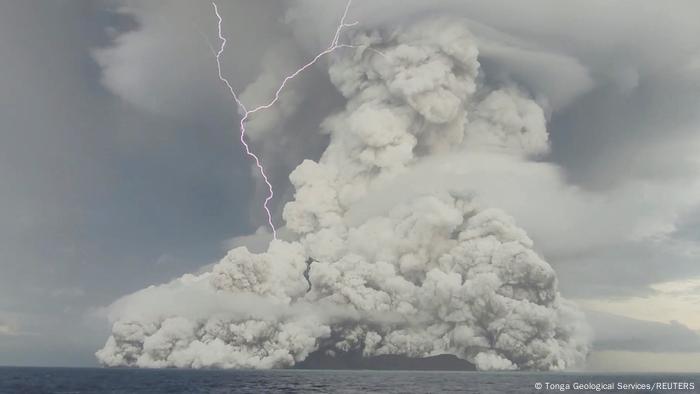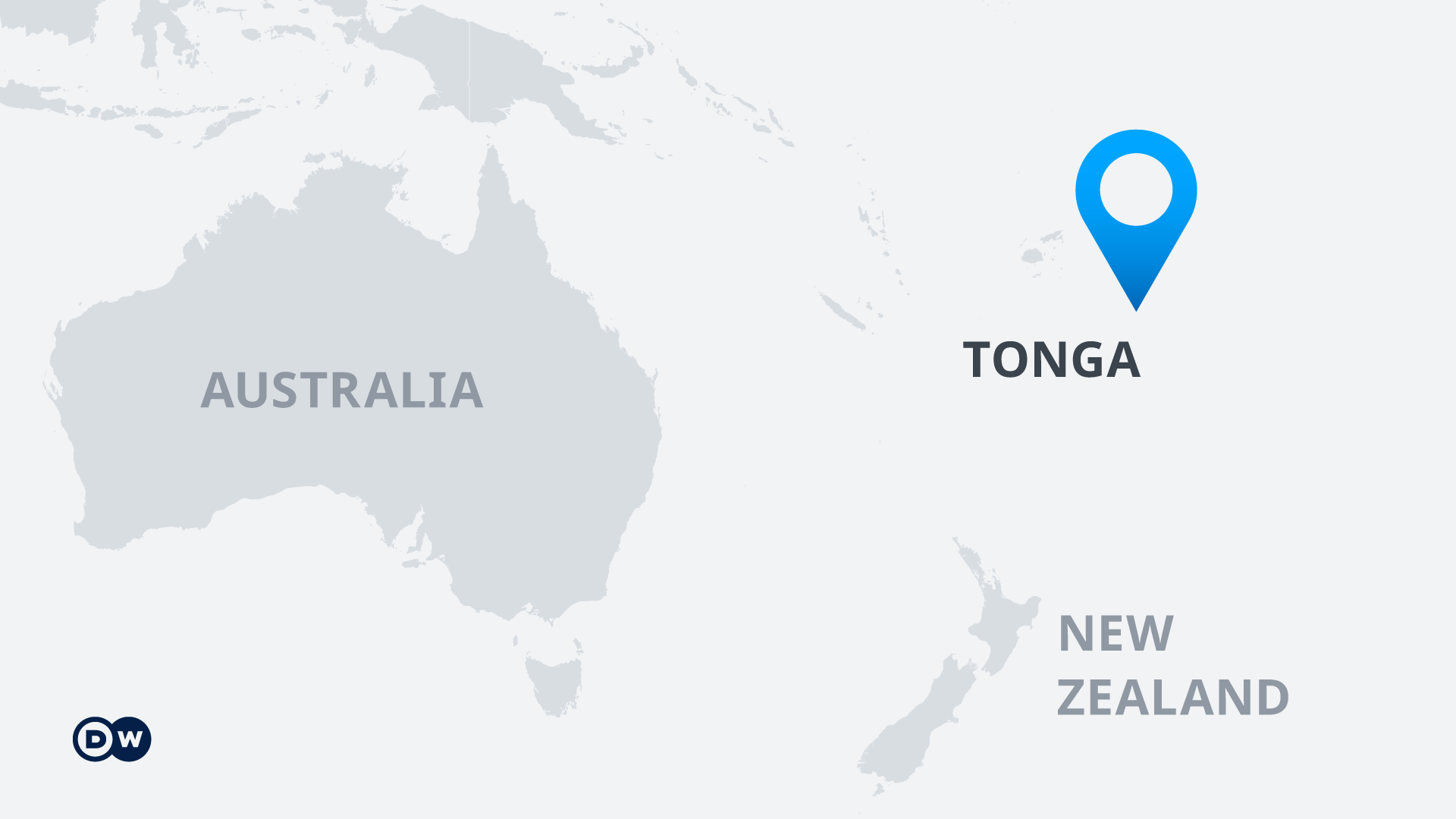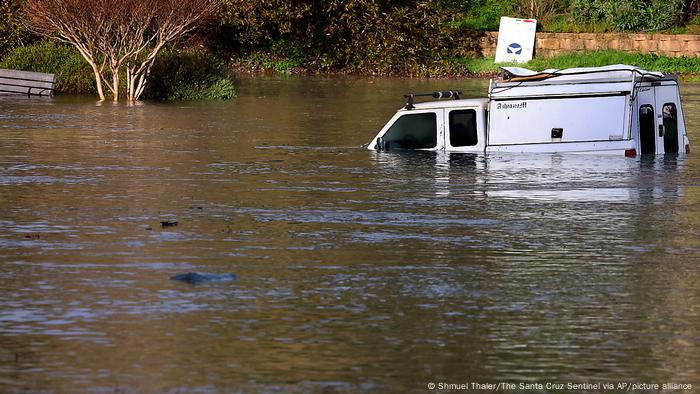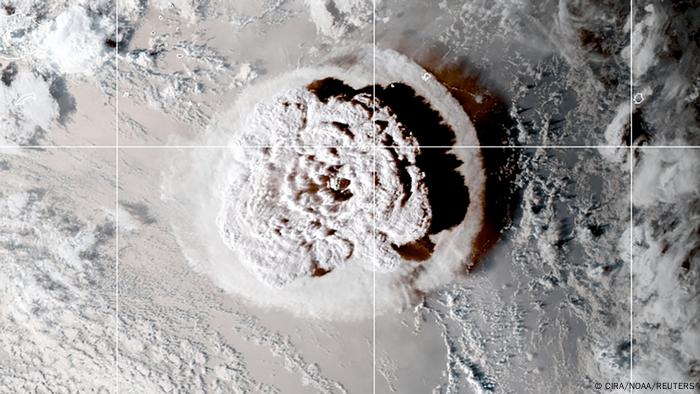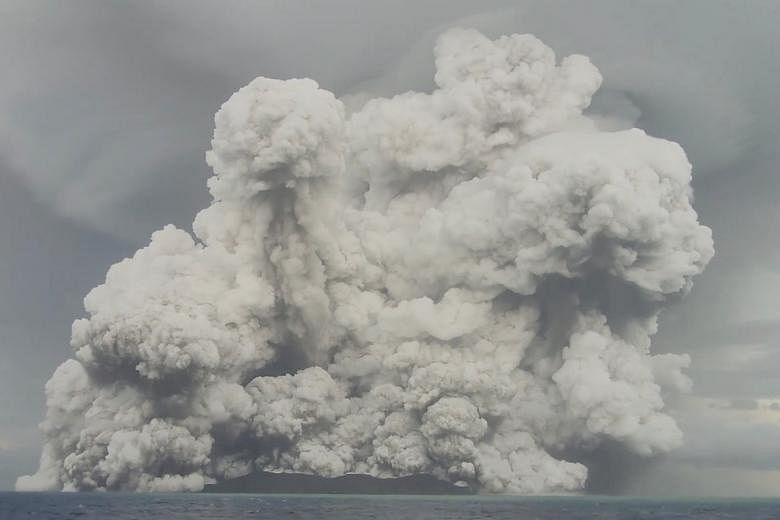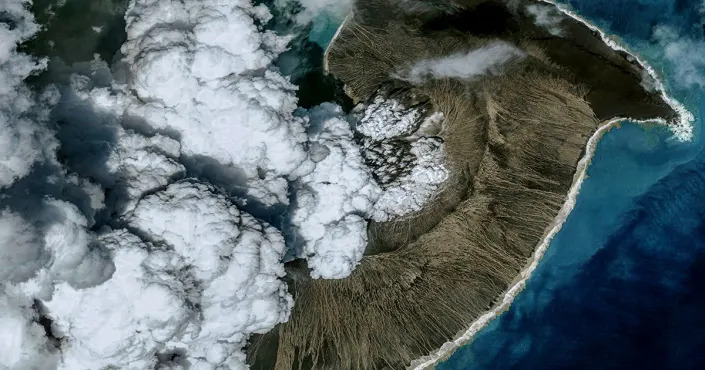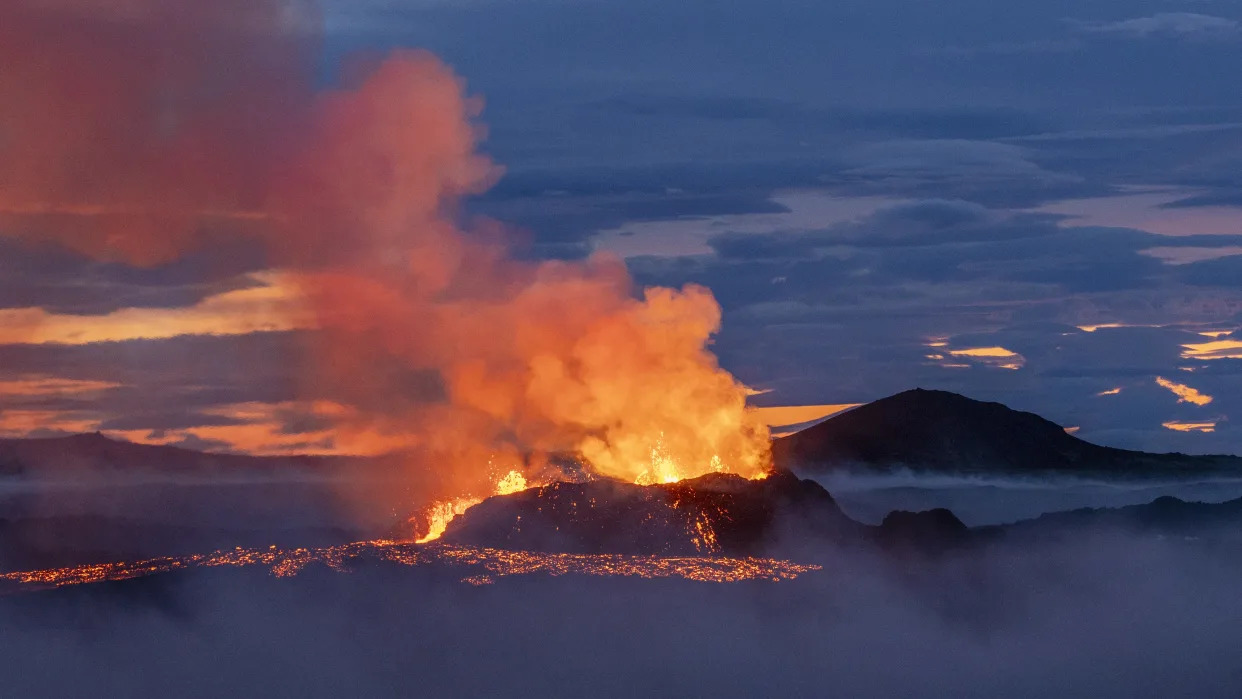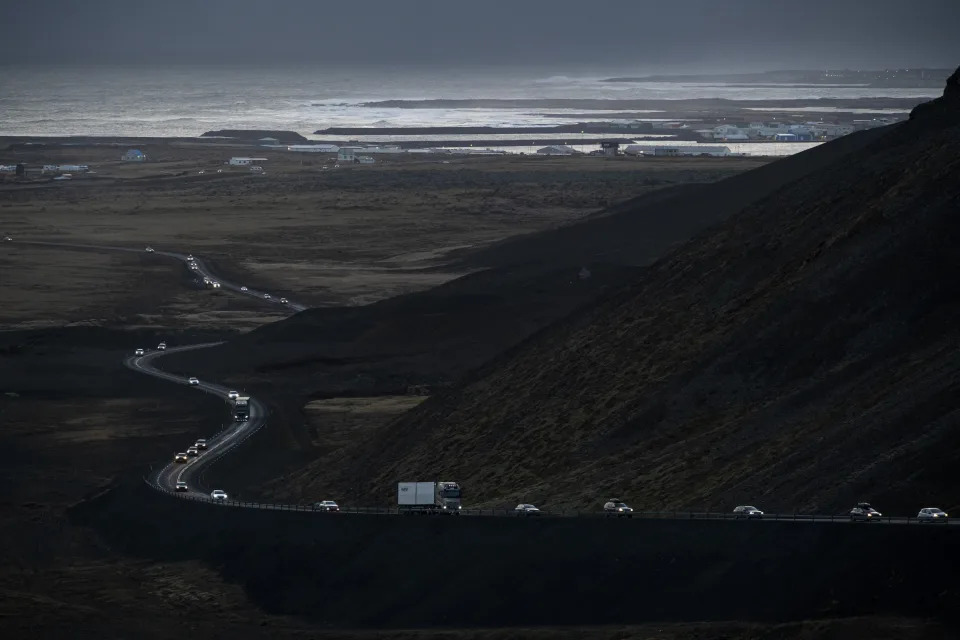EXPLAINER: Why Tonga eruption was so big and what’s next
By NICK PERRY

FILE - This satellite image provided by Maxar Technologies shows an overview of Hunga Tonga Hunga Ha'apai volcano in Tonga on Jan. 6, 2022, before a huge undersea volcanic eruption. (Satellite image ©2022 Maxar Technologies via AP,
WELLINGTON, New Zealand (AP) — People around the world looked on in awe at the spectacular satellite images of an undersea volcano erupting in a giant mushroom cloud in the Pacific. Many wondered why the blast was so big, how the resulting tsunami traveled so far, and what will happen next. New Zealand scientists Shane Cronin, a volcanology professor at the University of Auckland, and Emily Lane, a tsunami expert at the National Institute of Water and Atmospheric Research, help explain.
EXPLOSIVE BUT BRIEF
The eruption on Saturday was incredibly explosive but also relatively brief. The plume rose into the air more than 30 kilometers (19 miles) but the eruption lasted only about 10 minutes, unlike some big eruptions that can continue for hours. Cronin said the power of the eruption of the Hunga Tonga Hunga Ha’apai volcano ranks among the world’s biggest over the past 30 years, and the height of the plume of ash, steam and gas was comparable with the huge 1991 eruption of Mount Pinatubo in the Philippines, which killed several hundred people
WHY SO BIG?
The magma inside the volcano was under enormous pressure and had gasses trapped within it. A fracture in the rock likely induced a sudden drop in pressure, allowing the gas to expand and blast the magma apart. Cronin said the crater was sitting about 200 meters (650 feet) below the sea surface, a kind of Goldilocks depth for a big explosion in which seawater pours into the volcano and turns instantly into steam, adding to the rapid expansion and energy of the explosion. Any deeper and the extra pressure of the water would have helped contain the eruption.
FARFLUNG TSUNAMI
Many scientists were surprised that a single eruption could produce a Pacific-wide tsunami of about 1 meter (3 feet) that smashed boats in New Zealand and caused an oil spill and two drownings in Peru. Lane said that oceanwide tsunamis are usually triggered by earthquakes that extend across huge areas rather than from a single volcano, essentially a tiny dot in the ocean. She said other factors may have been at play, such as an underwater flank of the volcano collapsing and displacing water. She said one interesting theory is that the shock wave, or sonic boom, from the volcano that traveled twice around the world may have pumped more power into the tsunami waves.
TONGA MAINLY SPARED
Another mystery is why the tsunami wasn’t bigger and more destructive in Tonga, which sits almost on top of the volcano.
“That’s the million dollar question,” Cronin said. “Looking at the images so far, the level of devastation is less than I was fearing.”
Authorities by Wednesday had confirmed three deaths in Tonga, with concerns remaining about people on some of the hard-hit smaller islands. Dozens of homes were destroyed.
Lane said that Tongans at least got some warning, both from the increased activity at the volcano the day before the eruption and from the incredibly loud bang when it erupted but before the tsunami hit, allowing many to scramble to higher ground. She said reefs, lagoons and other natural features may also have protected parts of Tonga, while amplifying the waves in certain areas.
FALLING ASH
The ash that has coated Tonga is acidic but not poisonous, Cronin said. Indeed, he has been advising Pacific responders that people may still be able to drink from their rainwater supplies even if some ash has fallen in, which will make the water more acidic and salty. He said it was a question of applying the taste test and if water became scarce, it would be better drinking ash-tainted water than stagnant water that might be contaminated with bacteria. New Zealand and other nations are trying to get water and other supplies to Tonga as quickly as possible. Cronin said all of Tonga’s soil comes from volcanic ash and the latest dump of ash would quickly wash into the ground and make the nation more fertile.
NO GLOBAL COOLING
Huge volcanic eruptions can sometimes cause temporary global cooling as sulfur dioxide is pumped into the stratosphere. But in the case of the Tonga eruption, initial satellite measurements indicated the amount of sulfur dioxide released would only have a tiny effect of perhaps 0.01 degree Celsius (0.02 Fahrenheit) global average cooling, said Alan Robock, a professor at Rutgers University.
WHAT’S NEXT
Cronin envisions two main scenarios for the volcano. The first is that it has exhausted itself for now and will go quiet for the next 10 to 20 years as magma slowly returns. A second scenario is that new magma rises up quickly to replace that which exploded, in which case there might be ongoing eruptions. But he believes the cracks and rifts caused by Saturday’s big explosion will allow more gas to escape, and subsequent eruptions won’t be as big, at least for now. Both Cronin and Lane agree there needs to be much better monitoring of the volcano — and others in Tonga — to help better predict future events.
___
Associated Press Science Writer Seth Borenstein in Kensington, Maryland, contributed to this report.
The science behind the Tonga volcanic eruption, tsunami
Jan 18, 2022 6:20 PM EST
PBS NEWS HOUR
By —John Yang
By —Ali Rogin
The first satellite images of the Pacific nation of Tonga after Saturday's volcanic eruption emerged Tuesday. The photos show the islands coated in ash. Despite the violent explosion, the Tongan government has reported just three deaths. The status of two smaller islands in its chain is still unknown. John Yang takes a closer look at the science behind the volcano, its explosion and aftermath.
Full Transcript
Judy Woodruff:
Today, the first satellite images emerged of the Pacific nation of Tonga following Saturday's volcanic eruption.
The photos show the islands coated in ash. Despite the violent explosion, the Tongan government has so far reported just three deaths. The status of two smaller islands in its chain is still unknown.
John Yang takes a closer look at the science behind the volcano, its explosion and aftermath.
John Yang:
Judy, scientists say the explosion revealed some of the mysteries of underwater volcanoes. It produced a tsunami that was felt on the coasts of Japan and the United States, 5,000 miles away, and triggered an oil spill in Peru. It set off a lightning storm that lasted seven hours and had 400,000 strikes. It was heard as far away as Alaska.
But for all the ways it made itself felt around the world, its damage was relatively confined. Tonga bore the brunt of the volcano's fury, blanketed with ash that is now contaminating its water supply.
Michael Poland is a research geophysicist with the U.S. Geological Survey's Cascades Volcano Observatory in Vancouver, Washington.
Mr. Poland, thanks so much for joining us. As we talk about, it was so dramatic, this event, that huge plume that was visible from space, the tsunami, the atmospheric shockwave which rippled around the globe, but you say that the data actually showed this was a relatively small eruption.
Explain that.
Michael Poland, U.S. Geological Survey:
Yes, it's a very confounding event, in that the amount of material that came out of the ground was not especially huge.
It was perhaps the kind of thing we might see every few years from a volcano somewhere on Earth. But it produced an outsized explosion, really a massive explosion. And that has to have something to do with the interaction with ocean water, and to produce that really massive tsunami.
So it's having really outsized impacts for the amount of material that came out of the ground.
John Yang:
And what was in that material? What did come out of the ground?
Michael Poland:
Well, there was a lot of ash that came out, of course, as with most volcanic eruptions, and SO2 gas, among other types of gas, water vapor, and so forth.
And that sulfur dioxide really allows us to pinpoint where the plume is and how big it is, because we know roughly the amount of sulfur gas that's dissolved in the magma. So it's a bit like opening a soda and having that carbon dioxide come out of the soda. When the gas comes out of the volcano, you get a lot of SO2 that comes out of that magma. That allows us to track the plume and know roughly how big an eruption is.
John Yang:
And you talk about the reaction with the ocean water. Does that also — or what's the explanation for it being heard so far away, heard as far away as Alaska?
Michael Poland:
Yes, that's really difficult to understand at this point.
It had to have something to do with that sort of interaction. Perhaps a large amount of gas-rich magma being suddenly exposed to cold ocean water generated just a really massive explosion, and it was heard obviously, very, very far away. That's something I think is going to be the subject of an awful lot of research in the days, years to come.
John Yang:
And the tsunami, I think a lot of people's familiarity with tsunamis really comes from the 2004 Banda Aceh tsunami, which was the result of an earthquake, of a seismic event.
Is this common, a tsunami also common with volcanic eruptions under underwater like this?
Michael Poland:
Volcanic eruptions that are right underwater or right near the water can generate tsunamis. It's not something we see a lot of. Certainly, we see the earthquake-induced tsunamis much more commonly.
There's a lot of study that went into earthquake-induced tsunami, especially after 2004. And we have come to understand those sorts of processes a lot better than we did before. But volcanic tsunamis being rare give us fewer opportunities to study them.
So we don't understand the volcanic tsunamis quite as well. So a bit like that airwave that traveled around the Earth, this tsunami is also going to be studied quite intently to understand more about what generated it. Was it some displacement of the seafloor? Was it perhaps the impact of an ash plume on the water?
There are many potential mechanisms for why the tsunami was so big. And understanding that is going to be key to being able to forecast these sorts of events in the future.
John Yang:
As I hear you talk, it sounds like there's a lot we don't understand about underwater volcanoes, and that this is suggesting ways or new research, as you say, to examine this one.
What sorts of things will you be looking at and your colleagues be looking at it in this event?
Michael Poland:
I think the key here is that magma-water interaction.
And so there's going to be all kinds of attention paid to how magma and water interact. What happens when you put these two different materials in contact with another really in a dynamic way. So we're going to be looking at modeling studies of those sorts of interactions, studying the ash particles to see whether that can provide some clues as to how the interaction took place, and then modeling this explosion, modeling the tsunami, to try to understand more about the nature of this interaction, because, obviously, there are submarine volcanoes in other places.
And they're tremendously hard to study, because they are obscured. It's relatively easy to study volcanoes on land compared to these underwater volcanoes. But, clearly, they present a hazard. So we need to understand more about that hazard.
This event, as tragic as it is for Tonga, might help us understand these kinds of interactions in more detail. And that will help us in the future.
John Yang:
It's fascinating stuff.
Research geophysicist Michael Poland, thank you very much.
Michael Poland:
My pleasure.

